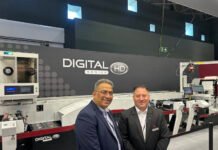
For those who have never investigated web offset as a solution for their flexible packaging production, the suggestion that it can actually work out to be significantly more cost effective than gravure and flexography is often greeted with surprise or disbelief.
There are a number of reasons why the process is not readily associated with flexible packaging; some are simply the result of misunderstandings about the core technology, while others are based on outdated perceptions based on yesterday’s market.
Addressing the issues
The two major challenges in flexible packaging printing and converting today are the demands for shorter runs and faster job changes. These can be bottom line killers. Previously, such jobs were taken on by converters to retain regular, longer-run business, but were rarely profitable. Today, those once-exceptional jobs are becoming the norm, and are now beginning to threaten the ongoing viability of some converting businesses.
In understanding why web offset can be a solution to many production conundrums, it is helpful to tackle one of the key confusions in the market: ‘short-run.’ The term short-run is used to mean significantly different things by different segments of the converting and general printing markets.
The rise of digital presses for flexible packaging printing moved the term ‘shortrun’ far below what conventional flexible packaging converters have traditionally done. At present, the largest digital press on the horizon has a one-meter webwidth and a 4-color printing speed of 300 fpm. Flexo and web offset presses are clearly in a separate category with speeds five times higher, or more, as well as wider web-widths and more colors possible.
It is more useful to think of digital run lengths as ‘micro runs.’ At present, the number of these micro runs and the total percentage of digitally printed flexible packaging are very small. Even the double-digit growth forecast for digitally printed flexible packaging over the next decade will not materially change the balance.
Losing micro runs to digital is not what’s putting pressure on flexo and gravure printers. It is the runs that are too long for digital, but too short for profitability — and their increasing popularity — that are causing the real problem.
Leveraging web offset’s strengths
Today’s web offset presses offer capabilities that can turn marginal short-run jobs into sustainable, profitable ones. With high productivity and fast, low-cost plate production and makereadies, web offset is far more capable than flexo to address short lead times and run lengths.
Other capabilities that reinforce the case include: print quality, greater color control and a standardized process, as does the ability to handle a wide variety of flexible substrates at high speeds. In the case of the Goss Sunday Vpak series of presses, its complex closed loop tension control system opens up the possibilities of web offset for substrates as fine as nine microns; films such as and including PET, BOPP, OPP and even LDPE. All of these have been run successfully on the Vpak in the Goss packaging technology center in Durham, (NH), USA, as well as at customer sites.
The Goss Sunday Vpak series builds on all the inherent advantages of web offset through innovative variable sleeve technology featuring quick-change blanket and plate cylinder sleeve adapters that make ‘infinitely’ variable repeat lengths even easier and more affordable.

With options for integrating flexo, gravure and digital stations into a Vpak press configuration to form a hybrid production line featuring UV and EB curing units, it delivers flexibility without compromise. Printers can continue to benefit from a wide range of coatings and finishing options. Of course, the ink water balance remains vitally important when introducing additional energy-curable inks and coatings, but the Vpak offers remote control with specific curves possible for each substrate and process. Working in conjunction with Alwan Color Expertise, Goss is currently working on the future of 7-color expanded gamut opportunities. This capability ensures repeatable color accuracy for press users across all applications, including labels, carton and board as well as flexible packaging printing, without the use of special or PMS colors.
The traditional flexible packaging sector is under great pressure. Accurately identifying the factors that are causing this pressure and addressing them is what will separate those who preserve their margins — and their businesses — from those who remain wedded to the way things have always been done. At present, the whole packaging market is in a state of change driven both by brands and consumers, but it is an exciting market with a bright future for those able to embrace that change.










